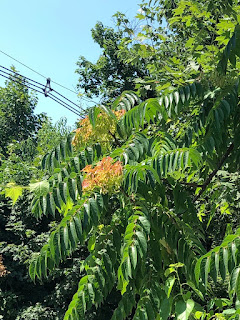The Main Circle
Look at the six trees in the circle in front of the main entrance. Under "Meditations" we have mentioned the lichen. We predicted that these trees were raised somewhere less polluted than the east coast or they would not have had so much lichen. The lichen are sensitive indicators of air pollution particularly lead particles. We said that the lichen does not damage the tree but needs a lot of light. Therefore it may predict that the leafy canopy in the summer may be thinner than ideal for the tree. The lichen should be more on the sunny south side. And we also guessed that the trees may be a cultivar of honey locust.
But here the point is confirm the identification and watch the dynamic changes in the next three months. As far as the ID, there is a faint memory of pinnately compound leaves. Ordinarily we would ( for variant of honey locust) be looking for thorns on the limbs and pods on the ground. But if you were a tree wanting to be widely planted, you might produce a variation without thorns and without pods. So we just have the twigs and buds which are consistent with honey locust but with a lot of variation in the twig illustrations, few of which are the special cultivars. It will be clearer by April.
As far as the dynamics, the twigs will go from this relatively dormant state to producing large pinnately compound leaves in just a few weeks. Don't know pinnately compound? If the ID is correct you will in May. There will be multiple steps, from bud to mature leaf, hard to say which is more important, other than WOW. You can make your own time lapse photos in your head as you pass by to the main entrance. A magnifying loupe may help, especially for the kids.
But here the point is confirm the identification and watch the dynamic changes in the next three months. As far as the ID, there is a faint memory of pinnately compound leaves. Ordinarily we would ( for variant of honey locust) be looking for thorns on the limbs and pods on the ground. But if you were a tree wanting to be widely planted, you might produce a variation without thorns and without pods. So we just have the twigs and buds which are consistent with honey locust but with a lot of variation in the twig illustrations, few of which are the special cultivars. It will be clearer by April.
As far as the dynamics, the twigs will go from this relatively dormant state to producing large pinnately compound leaves in just a few weeks. Don't know pinnately compound? If the ID is correct you will in May. There will be multiple steps, from bud to mature leaf, hard to say which is more important, other than WOW. You can make your own time lapse photos in your head as you pass by to the main entrance. A magnifying loupe may help, especially for the kids.



Comments
Post a Comment